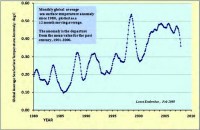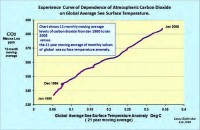
|
Apr 26, 2008
Ozone Hole Recovery May Reshape Southern Hemisphere Climate Change And Amplify Antarctic Warming
Science Daily
A full recovery of the stratospheric ozone hole could modify climate change in the Southern Hemisphere and even amplify Antarctic warming, according to scientists from the University of Colorado at Boulder, the National Oceanic and Atmospheric Administration and NASA. The authors used a NASA supercomputer model that included interactions between the climate and stratospheric ozone chemistry to examine how changes in the ozone hole influence climate and weather near Earth’s surface, said Perlwitz.
While Earth’s average surface temperatures have been increasing, the interior of Antarctica has exhibited a unique cooling trend during the austral summer and fall caused by ozone depletion, said Judith Perlwitz of the Cooperative Institute for Research in Environmental Sciences, a joint institute of CU-Boulder and NOAA. “If the successful control of ozone-depleting substances allows for a full recovery of the ozone hole over Antarctica, we may finally see the interior of Antarctica begin to warm with the rest of the world,” Perlwitz said. Read more here.
Icecap Note: Two things to note, they are using references to the “end of the 21st century” - which they like to do because none of us will be around to verify. Also note these scientists must not be aware or are ignoring the JPL findings reported in Nature last October, that the orginal consensus on man made causes for the ozone hole had collapsed. Laboratory experiments properly done at the appropriate pressures showed the rate of chemical reaction too small to be responsible, suggesting natural causation. The finding caused quite a stir with reactions like: “Our understanding of chloride chemistry has really been blown apart, says John Crowley, an ozone researcher at the Max Planck Institute of Chemistry in Mainz, Germany. “Until recently everything looked like it fitted nicely,” agrees Neil Harris, an atmosphere scientist who heads the European Ozone Research Coordinating Unit at the University of Cambridge, UK. “Now suddenly it’s like a plank has been pulled out of a bridge.” This was followed by a CYA study suggesting it was jut a delay.
Apr 23, 2008
Scientist Who voted for Gore in 2000 Now Debunks Warming Fears
By Dr. Don J. Easterbrook, Professor Emeritus Geology, Western Washington University
We’ve been warming up about a degree per century since the Little Ice Age in about 1600. We’ve been warming for 400 years, long before human-generated CO2 could have anything to do with the climate. If we project the previous century into the coming one, my projection is that we will have about a half-a-degree of cooling from 2007 (plus or minus three to five years) to about 2040. Then it will start getting warmer as we enter the next warm cycle, followed by cooling again.
For a number of interviews, especially in the national news media, they ask ‘Are you a Republican?’ and I say ‘No, Iím not, as a matter of fact, I voted for Al Gore. I donít want to pick on him because heís not a scientist.’ The nonsense he spews comes from the IPCC [United Nations Intergovernmental Panel on Climate Change], so in a sense I don’t condemn him as much as I do the so-called climatologists like [James] Hansen, who says things that are idiotic. They’re the ones giving him all this stuff.
Al Gore makes a hundred-million dollars? He has five-billion in his slush fund? Look at [U.S. Senator] Barbara Boxer, she sponsored a bill for carbon cap and trade [Sanders/Boxer Global Warming Bill S.309]. Who will benefit from hundreds of billions of dollars for administering a scheme like that? The other thing is research funding. The U.S. spends about two-billion dollars a year on research. Right now, if you submit anything that says CO2 is not the bad guy, you wonít have a chance of getting funding. It all goes to the CO2 people who build little fiefdoms; they have grant money coming out of their ears. They mimic Al Gore and say the debate is over. The last I heard, the U.S. plans to increase its research spending to 3.5 billion dollars, virtually all of which goes into CO2 research.
The last part of this equation is the news media and money being made by people like National Geographic who recently put out a show called Six Degrees of Global Warming [Six Degrees: Our Future on a Hotter Planet, by Mark Lynas] and how many people watched that and watched the ads that went with it? How much money did they make doing it? How much money would they have made if they’d said ‘Oh, it’s not CO2, it’s solar?’ Doom and gloom is easy to sell. Herman Goebbels said in World War II, and said it right, that if you tell a big enough lie often enough, people will eventually believe it. Today is like that, total hogwash. Gore made a statement that less than a half-dozen people in world don’t believe that CO2 causes AGW. That’s totally nuts. Read more and an interview with Dr. Easterbrook here.
Apr 22, 2008
Little Ice Age in Southern South America?
World Climate Report
The article was generated by a research team from Chile’s Universidad de Concepcion and the Pontificia Universidad Catolica de Valparaiso. Araneda et al. begin their piece noting that “Of all the climatic changes during the Holocene, the recent cooling period, the ‘Little Ice Age’(LIA), is one of the most broadly recognized events in the Northern Hemisphere. However, the duration and timing of the event has been disputed.” Furthermore, they note “A problem for the definition of the LIA is its variable timing and duration in different regions; thus, its synchronicity as a global phenomenon is still a matter of debate.” Once again, we learn that “debate” in climate change is still alive and well!
The research team concludes “The major contribution provided by the documentary evidence has been to confirm the occurrence of a cold period in the Laguna San Rafael area, which would be within the temporal window defined for the European LIA.” Furthermore, they conclude that “the sole historical evidence suggests that warm conditions prevailed around 1675, a date in which the front of the San Rafael glacier did not extend beyond the eastern shoreline of the lake. Later, a cooling period occurred from 1766 to 1898, with a peak between 1857 and 1871, during which the glacier advanced up to 8 km into the interior of the Laguna San Rafael. This cooling period declined after 1898, as evidenced by the decrease of the San Rafael glacier, which had retreated 1 km by 1904.” Most importantly to us at World Climate Report, they clearly state at the end “The recognition of the LIA in Northern Patagonia, through the use of documentary sources, provides important, independent evidence for the occurrence of this phenomenon in the region.” There are those who will insist that the Little Ice Age was not a global event, but somehow, just as the Northern Hemisphere cooled during the Little Ice Age, glaciers were expanding in southern South America? Starting to sound global to us! Read full report here.
Apr 21, 2008
Oceans Are the Main Regulators of Carbon Dioxide
Dr. Lance Endersbee paper published in Engineers Australia magazine
Recent data on global average sea surface temperatures derived from satellite observations has revealed some interesting correlations between sea temperatures and atmospheric carbon dioxide. Figure 1 shows the global average sea surface temperature anomaly since 1980. The anomaly is defined as the departure of the actual temperature from the mean global average for the past century (1901-2000). The data is derived from satellite coverage, and is much more consistent than previous data based on surface measurements. Note the cyclic behaviour and the peak in 1999. There has been overall cooling since 1999. The causes of the cyclic behaviour are not known. The major influences are probably the El Nino and La Nina events, and variations in heat flow on the ocean floor from undersea volcanoes and vents. These factors may be related through a common cause. It is difficult to see any influence of human activity in the variations of sea surface temperatures shown in the chart. The present winter in the northern hemisphere has been the coldest for several decades.

See larger image here
Figure 2 shows the direct relationship between sea surface temperature and carbon dioxide levels in the atmosphere since 1980. It is based on a 21-year moving average of sea surface temperatures, and a 12-month moving average of carbon dioxide levels. As the sea temperature has increased, so has the carbon dioxide level. This reflects the normal solubility relationship between carbon dioxide and water. As the sea temperature increases, the oceans breathe out carbon dioxide into the atmosphere. Thus, if sea surface temperatures now continue to fall, we may expect carbon dioxide levels to decrease. There is strong consistency from December 1984 onwards, which reflects the better accuracy and consistency of the temperature records from satellite data.

See larger image here
Read more here.
Emeritus Professor Lance Endersbee is a past national president of Engineers Australia.
Apr 20, 2008
World’s Oldest Tree Rewrites Climate History, Challenges Global Warming
By Noel Sheppard, Newsbusters
Scientists used to believe the oldest trees on the planet were in North America with ages in the 5,000-year range. Hooey, for a new discovery in Sweden has completely debunked this consensus, resulting in a total rewrite of climate history while bringing into serious question global warming theories espoused by Nobel Laureate Al Gore and his sycophant devotees. Think green media members will be falling over themselves to report this new finding? While you ponder, consider the evidence supplied by the British Telegraph Thursday.
The world’s oldest tree has been found in Sweden, a tenacious spruce that first took root just after the end of the last ice age, more than 9,500 years ago. The tree has rewritten the history of the climate in the region, revealing that it was much warmer at that time and the ice had disappeared earlier than thought. It had been thought that this region was still in the grip of the ice age but the tree shows it was much warmer, even than today, [Prof Leif Kullman at Umea University] says. “Spruces are the species that can best give us insight about climate change,” he says. The summers 9,500 years ago were warmer than today, though there has been a rapid recent rise as a result of climate change that means modern climate is rapidly catching up.
Hmmm. So, as a result of this find, we now know that summers in Sweden were not only much warmer 9,500 years ago than the consensus view used to be, but ALSO warmer than today, even after all that awful carbon dioxide that man has released into the atmosphere in the past couple of centuries.
As a post facto aside, this find should also point out how irrelevant a “consensus” is as it pertains to science, for new discoveries are always debunking and challenging conventional wisdom. Sadly, folks in the media, and climate alarmists looking to stifle debate, refuse to understand this inconvenient truth. That said, energy and financial policies SHOULD NOT be based on supposedly consensus views of science for EXACTLY this reason, for a lot of time, money, and resources could be devoted to a “solution” to a “problem” which ends up NOT existing. Read more here.
Noel Sheppard is an economist, business owner, and Associate Editor of NewsBusters
|
|
|
|




